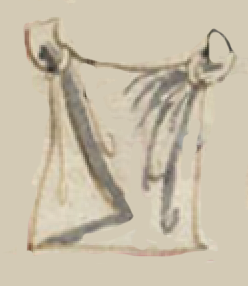tilmatli (CST12)
This painting of the simplex glyph for the term shows a frontal view of a tilmatli (cloak worn by a noble). The cloak is tied in each of the two upper corners, which is a hint that it would be tied together over a man’s shoulder. The cloak has gray lines of shading, producing a three-dimensionality.
Stephanie Wood
Note how this tilma compares to others, below. For more on the Codex Sierra, see Kevin Terraciano’s study (2021).
Stephanie Wood
1550–1564
Jeff Haskett-Wood
capas, tilmas, telas

tilma(tli), a cloak for a noble, or a length of cloth, https://nahuatl.wired-humanities.org/content/tilmatli
capa, o tilma
Stephanie Wood
Códice Sierra-Texupan, plate 12, page dated [1]554. Origin: Santa Catalina Texupan, Mixteca Alta, State of Oaxaca. Kevin Terraciano has published an outstanding study of this manuscript (Codex Sierra, 2021), and in his book he refers to alphabetic and “pictorial” writing, not hieroglyphic writing. We are still counting some of the imagery from this source as hieroglyphic writing, but we are also including examples of “iconography” where the images verge on European style illustrations or scenes showing activities. We have this iconography category so that such images can be fruitfully compared with hieroglyphs. Hieroglyphic writing was evolving as a result of the influence of European illustrations, and even alphabetic writing impacted it.
https://bidilaf.buap.mx/objeto.xql?id=48281&busqueda=Texupan&action=sear...
The Biblioteca Digital Lafragua of the Biblioteca Histórica José María Lafragua in Puebla, Mexico, publishes this Códice Sierra-Texupan, 1550–1564 (62pp., 30.7 x 21.8 cm.), referring to it as being in the “Public Domain.” This image is published here under a Creative Commons license, asking that you cite the Biblioteca Digital Lafragua and this Visual Lexicon of Aztec Hieroglyphs.




